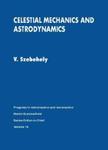版权所有:内蒙古大学图书馆 技术提供:维普资讯• 智图
内蒙古自治区呼和浩特市赛罕区大学西街235号 邮编: 010021

丛 书 名:Progress in Astronautics and Aeronautics
版本说明:1
I S B N:(纸本) 9781563478635
出 版 社:American Institute of Aeronautics and Astronautics
出 版 年:1964年
页 数:765页
主 题 词:Aerodynamics Aeronautical Engineering Aeronautics Aerospace Sciences Air Navigation Aircraft Navigation Systems Apollo Program Applied Mathematics Asteroids Astrodynamics Astrometry Astronautics Astronomical Observatory Astronomy Atmospheric Science Attitude Control Aviation Communication Avionics Computers Boundary Element Method Celestial Coordinate System Celestial Mechanics Classical Mechanics Communication System Communications Satellite Computational Fluid Dynamics Computer Programming and Language Computing and Informatics Computing, Information, and Communication Control Theory Coordinate System Earth Observation Satellite European Space Agency Flight Dynamics Flight Mechanics Fluid Dynamics General Physics Gradient Method Guidance, Navigation, and Control Systems Interdisciplinary Topics Kepler's Laws of Planetary Motion Launch Vehicles Lunar Science Mathematical Analysis Multidisciplinary Design Optimization NASA NASA Facilities NASA Programs Numerical Analysis Numerical Interpolation Optimal Control Theory Orbital Maneuvers Orbital Property Planetary Atmospheres Planetary Science and Exploration Planets RADAR Ranger Program Runge-Kutta Methods Satellite Broadcasting Satellite Ground Station Satellite Technology Satellite-Based Services Satellites Society and Aerospace Technology Solar Physics Solar Properties Solar System Moons Soviet Space Program Space Agencies Space Exploration and Technology Space Launch Systems Space Missions Space Orbit Space Science and Technology Space Systems Space Systems and Vehicles Spacecraft Design Spacecraft System Spacecrafts Spectrometers Spectroscopy Statistical Analysis Stellar Astronomy Telescopes Uncrewed Spacecraft
摘 要:This interdisciplinary book combines the astronomical and the engineering approaches to those questions of space research that are known as orbit and trajectory problems. The new word Astrodynamics (no reference to stellar dynamics) intends to represent a field that emphasizes the engineering aspects of dynamical astronomy. The application of a highly developed mathematical science which is soundly embedded in hundreds of years of tradition to the newest engineering problems is one of the most challenging tasks to representatives of both fields. This book intends to meet this challenge by covering the most significant and recent developments in a systematic, though not at all textbook like, manner. It is prepared for the worker in the field with background in celestial mechanics and with familiarity with the engineering *** chapters are organized according to the major functional subjects of space dynamics rather than along operational lines. Indeed, it is aimed at the discussion, first, of general ideas, and then these are interspersed with examples. Chapter 1 reports on the most advanced analytical methods, recently proposed and developed, that attack new and old problems of celestial mechanics. The second chapter is devoted to the physics of the solar system from the point of view of celestial mechanics. One of the major engineering problems of space dynamics, orbit selection, is the subject of the third chapter. Chapter 4 applies the general systems engineering aspects of the previous chapter to a specific mission. Probably the most popular subjects of space dynamics, orbit transfer, and optimization problems are treated in the fifth chapter. The last chapter deals with a classical subject of celestial mechanics, viz., the determination of orbits of objects already in motion. This chapter, therefore, closes the circle of subjects that starts with perturbation problems of celestial mechanics and ends with the inverse problem, i.e., orbit determination.